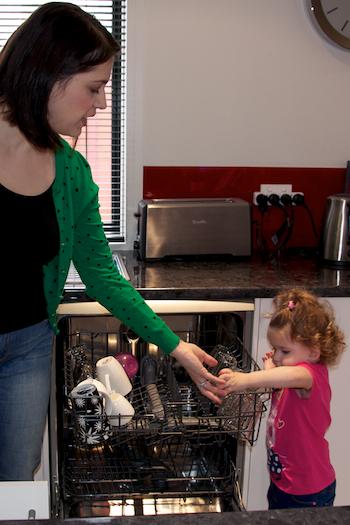Loading the dishwasher
Duration/age

How you load or unload the dishwasher can be unique to you or your family and might be different just because of the type of dishwasher you have. As you work with your child to load or unload the dishwasher, explain to them how you will go about the task and the reason for the decisions you are making.
This plate is longer and has sharp corners compared to the plate that has curved corners. This plate is thicker so will not fit in that slot.
If you have a dishwasher with one large door how do you stack the dishes inside? Do you start on the top shelf and work down or do you have set places where the dishes go? Maybe the big dishes go down the bottom and the smaller ones up the top.
I am going to place the small dishes up the top. I am putting the big, heavy dishes down the bottom. The big ones would not fit in the top drawer.
Does your dishwasher have two doors that allow you to do a half wash? What do you load into the top half compared to the bottom?
Once the dishes are all clean is there a specific way that you unpack the dishwasher?
Do you start with the top shelf or go straight to the bottom? Do you unload all of the plates before starting to put away the cutlery or do you put away the dishes that are closest to you?
Do you take the dishes out of the dishwasher one at a time and place them on the sink next to you to make a stack before putting them away? Or do you put each dish away one at a time?
Materials you will need
- Dishwasher
- Dishes
Skills this activity improves
Why does this matter?
As children help to load and unload the dishwasher they are exploring space, measurement, planning, sorting and grouping objects by shape, size and function. Learning to notice and describe the different attributes of an object - such as size or shape - helps children to notice small details and compare the differences between objects that may look the same.
Noticing the different attributes of an object helps children to group objects and then order the task. ‘The items that are the heaviest should be placed at the bottom and the lighter objects placed at the top.’
What does this lead to?
Once a child is able to notice the differences between objects then they can work out how to use them and to move them around and within space.
Noticing small details is an important skill when learning to read. Often when children begin to read they do not notice the difference between letters that look similar and see them as the same. When children are able to notice the difference in letters they are able to quickly identify what a word is without having to stop and read every letter individually.
Sorting and grouping helps children to explore measurement and the function of groups of objects. ‘A glass is something that we drink from, its job is to hold liquid.’ We could also describe it by what it is made from, its size or the shape of the glass.
Language to use
- Small, large, big, little, medium
- Plate, bowl, cutlery, cup, glass, saucepan
- Top, bottom, middle
- Front, back, sides
- Clean, dirty
Questions to use
- Where will the plate fit?
- Is the top row full?
- Can you fit any more cups at the back?
- Has the dishwasher finished?
- Is the dishwasher full and ready to start?
Useful tips
- You might also like to take a look at the activities Packing your bag and Packing the lunch box.
- For safety information visit www.parenting.sa.gov.au.
- Remember to talk to your child in your home language.
Variation by age
3 to 5 year olds
- Ask your child to help you set the table.
- Ask your child to help put away the dishes from the dishwasher.
- Get your child to predict where the dish will go in the dishwasher based on its size.
Questions to ask
- Where will this go?
- Which dish should we put away first?
- Which shapes are the same?
Language to use
- Round, square, oval
- Flat, curved, thick, thin
- Middle, edge, corner, side


